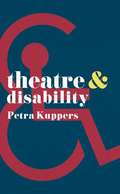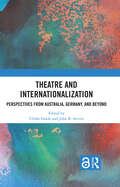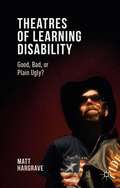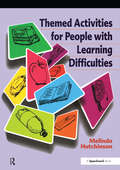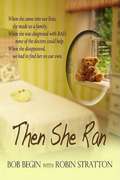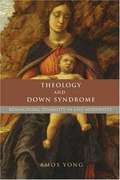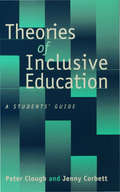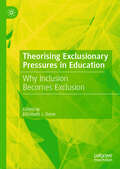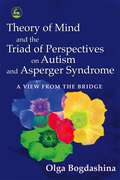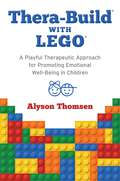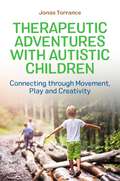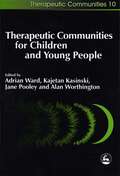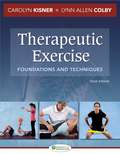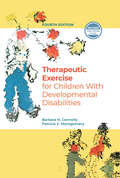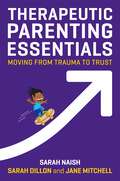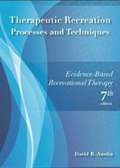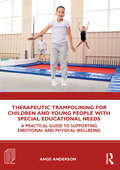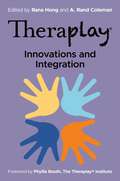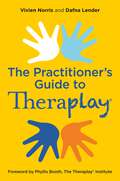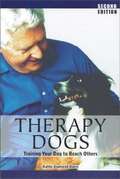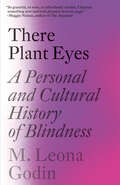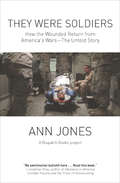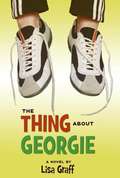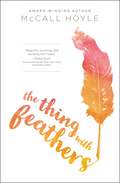- Table View
- List View
Theatre and Disability
by Petra KuppersThis succinct and engaging text examines the complex relationship between theatre and disability, bringing together a wide variety of performance examples in order to explore theatrical disability through the conceptual frameworks of disability as spectacle, narrative, and experience.
Theatre and Internationalization: Perspectives from Australia, Germany, and Beyond
by Ulrike Garde John R. SevernTheatre and Internationalization examines how internationalization affects the processes and aesthetics of theatre, and how this art form responds dramatically and thematically to internationalization beyond the stage. With central examples drawn from Australia and Germany from the 1930s to the present day, the book considers theatre and internationalization through a range of theoretical lenses and methodological practices, including archival research, aviation history, theatre historiography, arts policy, organizational theory, language analysis, academic-practitioner insights, and literary-textual studies. While drawing attention to the ways in which theatre and internationalization might be contributing productively to each other and to the communities in which they operate, it also acknowledges the limits and problematic aspects of internationalization. Taking an unusually wide approach to theatre, the book includes chapters by specialists in popular commercial theatre, disability theatre, Indigenous performance, theatre by and for refugees and other migrants, young people as performers, opera and operetta, and spoken art theatre. An excellent resource for academics and students of theatre and performance studies, especially in the fields of spoken theatre, opera and operetta studies, and migrant theatre, Theatre and Internationalization explores how theatre shapes and is shaped by international flows of people, funds, practices, and works.
Theatres of Learning Disability
by Matt HargraveThis is the first scholarly book to focus exclusively on theatre and learning disability as theatre – rather than advocacy or therapy. Matt Hargrave provocatively realigns many of the (hitherto unvoiced) assumptions that underpin such practices, and opens up a new set of critical questions. Stemming from a close engagement with the work of several very different theatre companies – including Mind the Gap (UK); Back to Back (Australia) - and unique solo artists such as Jez Colborne, this book shifts the emphasis from questions of social benefit towards a genuine engagement with aesthetic judgement. Hargrave examines the rich variety of contemporary theatrical practices in this field and spans a wide range of forms such as site specific, naturalistic and autobiographical performance. The book examines ways in which the learning disabled performer might be read on stage, and the ways in which s/he might disturb assumptions, not least about what acting or artistic authorship is. This is an important and timely study for all upper-level theatre and performance students and scholars alike, as well as a provocative contribution to debates within disability studies.
Themed Activities for People with Learning Difficulties
by Melinda HutchinsonUser-friendly and practical, this is an excellent resource for all professionals looking to run creative sessions with people with profound and complex learning difficulties. Using a selection of twenty everyday objects, it provides resource materials, ideas and flexible structures to extend and complement professionals' existing approaches. It examines a range of teaching approaches, ideas for adapting activities and equipment, and how to present materials and tasks to the student while providing ideas, work outlines, activities and methods, recording sheets and photocopiable materials. It can be used with individuals and groups in a variety of settings, including educational establishments, day provisions or at home and is designed to provide opportunities for participation at all ability levels. With the help of this book, the list of object-based activities is endless!
Then She Ran
by Robin Stratton Bob BeginDespite repeated warnings to doctors at the mental health care facility where their special-needs daughter was being kept, Bob and Patty Begin received the late-night phone call they dreaded most: Cecilia had escaped and no one knew where she was. Arrogance and negligence in the medical community and Massachusetts' lack of a systematic process for locating runaways meant that Bob and Patty would have to organize and head the desperate search by themselves.
Theology And Down Syndrome: Reimagining Disability In Late Modernity
by Amos YongWhile the struggle for disability rights has transformed secular ethics and public policy, traditional Christian teaching has been slow to account for disability in its theological imagination. Amos Yong crafts both a theology of disability and a theology informed by disability. The result is a Christian theology that not only connects with our present social, medical, and scientific understanding of disability but also one that empowers a set of best practices appropriate to our late modern context.
Theories of Illness: World Survey
by George Peter MurdockTheories of Illness establishes a new landmark in comparative studies. Utilizing concepts from modern medicine and anthropological theory, Professor Murdock distinguishes the natural causes of illness from theories of supernatural causation. He subdivides the latter into theories of illness that are related to aggression (witchcraft, sorcery, and spirit aggression) and those which are related to guilt and a sense of sin (taboo violation and mystical retribution). Obviously, these relate to man's most basic beliefs as revealed in early religions.
Theories of Inclusive Education: A Student′s Guide
by Peter Clough Jenny Corbett`As a doctoral student, currently writing a dissertation which focuses on inclusive education, I found this an excellent supportive resource. It brings together the major theorists of the last 20 years and very importantly highlights the perceived change in Mary Warnock′s stance towards statementing since the late 1970s. This element of change in the individual, society and policy is an issue which runs through the book and from an emancipatory and postmodernist stance is a vital inclusion. The inclusion of personal reflections greatly adds to the text, instilling a confidence in the student that there is value in being a person with a point of view. For me the publication of the book comes after my own critical analysis of the literature. From a purely selfish aspect, I wish it had been published earlier in my studies. An excellent resource that I would thoroughly recommend - Amazon Review This book traces the major stages of thinking in the development of inclusive education. It provides overviews of the main theoretical influences: the medico-psychological model; sociological positions; curriculum studies; school effectiveness and the impact upon policy and practice of the Disability Movement. Positioned and discussed in their historical contexts the book provides a synopsis and critique of the last 50 years of the 20th century, including the introduction of the term ′special educational needs′, the practice of integration and the present processes of inclusive education. The unique features of this book include personal reflections by a number of people who are considered to have had a major influence in the development of Inclusive Education. Summaries of their work, their writing and their thinking are provided - drawn from interviews with them and their own publications. The book identifies and embraces some major issues. It does so bearing in mind the interests and perspectives of students working within Inclusive education studies and presents some complex issues in an accessible format with a direct style. Linking directly to the student experience, the book concludes with examples of how students have used theories on inclusive education to inform their reflections on practice. The book throughout is deliberately learner-friendly, using sample- group activities and suggested readings, and is designed to be an effective course reader.
Theorising Exclusionary Pressures in Education: Why Inclusion Becomes Exclusion
by Elizabeth J. DoneThis book, a follow-up edition to International Perspectives on Exclusionary Pressures in Education (Palgrave Macmillan, 2023), presents an overview of inequality and inequity along different dimensions of exclusionary practices in schools and other educational settings. Contributions provide a range of theoretical perspectives which are applied to exclusionary practices and pressures in particular educational contexts, and equip readers with varied theoretical or conceptual frameworks through which contested issues around social justice and inclusive education can be acknowledged and analyzed. The book fosters a broad understanding of inclusive education by demonstrating how exclusionary pressures relating to disability, gender, socio-economic status, race and ethnicity, refugee status and sexuality work to trouble or problematize political, professional and policy rhetoric and discourses in which inclusive practices are assumed to be established. The book is of interest to researchers and students interested in intersectionality in inclusive and special education.
Theory of Mind and the Triad of Perspectives on Autism and Asperger Syndrome: A View from the Bridge
by Olga BogdashinaInspired by the often uncomfortable interplay between autistic individuals, parents and professionals in understanding autistic spectrum conditions, Olga Bogdashina uses the concept of Theory of Mind (ToM) to consider these groups' different (and often conflicting) perspectives. ToM is the ability to imagine and make judgements about what others feel and think; its absence in autistic individuals is called 'mindblindness'. This book addresses the 'mindblindness' of people united in their interest in autism but divided by their different angles and perspectives. Divided into four parts, the book first defines autism, then the views of the three main groups working with it - autistic individuals, parents and professionals - under the headings of classifications, diagnosis, causes, development, theories and treatment. By comparing and reconciling the different perspectives in this way, the book helps each group to understand and predict each other's responses and behaviours. This enlightening and innovative book offers a unique way of 'stepping in each other's shoes' and is a valuable resource for all people living or working with autism.
Thera-Build® with LEGO®: A Playful Therapeutic Approach for Promoting Emotional Well-Being in Children
by Alyson Thomsen'Thera-Build' is a LEGO®-based therapeutic approach for improving children's emotional well-being. Participation in Thera-Build groups can help to boost self-esteem, address common issues such as anxiety and anger, support social development and build positive attachments. This inspiring and user-friendly guide explores the power of play, introduces the basics of brain plasticity and attachment theory, and shows exactly how to set up and run an effective Thera-Build group. A wide range of imaginative games and activities is included.
Therapeutic Adventures with Autistic Children: Connecting through Movement, Play and Creativity
by Jonas TorranceA vivid exploration of working with autistic children using empowering techniques from a range of creative therapies. Each chapter in this heartening book is the story of a child with autism and how therapy was pivotal in confronting his or her individual dilemma. Covering many of the behaviours characteristic to autism, such as uncontrolled anger and obsessive tendencies, the therapies used range from drawing and dancing to meditation and martial arts, depending on the needs and interests of each child. The key message is that investing in the relationship between the therapist and the child - so that they grow, play and develop together - is transformative.
Therapeutic Communities for Children and Young People
by Alan Worthington Jane Pooley Kajetan Kasinski Adrian Ward Linnet McmahonTackling the difficult issues facing those who work with traumatized and sometimes dangerous young people and their families, this new volume shows how professionals can bring about positive change and growth through the creation of "holding" and healing therapeutic environments. This collection of papers written by established and respected experts with extensive practice and research experience builds a powerful picture of the theory and practice of therapeutic community work with young people. A wide variety of therapeutic community approaches is considered alongside an analysis of the implications of this model for mainstream residential practice. Social work, health care and education professionals will find the text invaluable for its presentation of a well-founded analysis of their work with these most damaged and desperate children and young people.
Therapeutic Exercise: Foundations and Techniques (Sixth Edition)
by Carolyn Kisner Lynn Allen ColbyThoroughly revised and updated throughout, Kisner & Colby's 6th Edition offers the most up-to-date exercise guidelines for individualizing interventions for those with movement disorders. Now with contributions from the leading experts in the field, it encompasses all of the principles of therapeutic exercise and manual therapy, including spinal surgery and spinal manipulation. This renowned manual remains the authoritative source for exercise instruction for the therapist and for patient self-management.
Therapeutic Exercise for Children with Developmental Disabilities
by Barbara H. Connolly Patricia MontgomeryTherapeutic Exercise for Children With Developmental Disabilities has been expanded and updated to include everything a student or professional needs to know when working with children with developmental disabilities. Continuing the emphasis on evidence-based practice from the previous editions, this comprehensive Fourth Edition enhances critical thinking and evaluation skills. Throughout the course of the text, Drs. Barbara H. Connolly and Patricia C. Montgomery present case studies of 5 children with various developmental disabilities to bring a problem-solving approach to each individual chapter topic. The case studies include 2 two children with cerebral palsy (GMFCS Levels I and V), a child with myelomeningocele, a child with Down syndrome, and a child with developmental coordination disorder and attention-deficit hyperactivity disorder. Each chapter’s examination, evaluation, and intervention recommendations are accompanied by specific treatment objectives and therapeutic activities, plus a companion website with 17 videos, which contains 90 minutes of content to illustrate concepts. Recent research and clinical recommendations, as well as related references, are also provided in each chapter. This Fourth Edition utilizes the American Physical Therapy Association’s Guide to Physical Therapist Practice 3.0 and the World Health Organization’s International Classification of Functioning, Disability, and Health--Children and Youth as its framework. The focus of the chapters is on children’s participation and empowerment, rather than body function and structure. Examples of new and updated topics in the Fourth Edition: • Practice in the NICU • Early mobility strategies • Communication strategies with children and families • Aquatic therapy • Upper extremity constraint-induced therapy • Mirror therapy • Lower extremity treadmill training With helpful videos, informative figures, and compelling case studies, Therapeutic Exercise for Children With Developmental Disabilities, Fourth Edition is the perfect resource for both students and practicing clinicians.
Therapeutic Parenting Essentials: Moving from Trauma to Trust (Therapeutic Parenting Books)
by Sarah Naish Sarah Dillon Jane MitchellAll families of children affected by trauma are on a journey, and this book will help to guide you and your family on your journey from trauma to trust.Sarah Naish shares her own experiences of adopting five siblings. She describes how to use therapeutic parenting - a deeply nurturing parenting style - to overcome common challenges when raising children who have experienced trauma. The book describes a series of difficult episodes for her family, exploring both parent's and child's experiences of the same events - with the child's experience written by a former fostered child - and in doing so reveals the very good reasons why traumatized children behave as they do. The book explores the misunderstandings that grow between parents and their children, and provides comfort to the reader - you are not the only family going through this!Full of insights from a family and others who have really been there, this book gives you advice and strategies to help you and your family thrive.
Therapeutic Recreation Processes & Techniques: Evidenced-Based Recreational Therapy
by David R. AustinIn fact, the subtitle, "Evidence-Based Recreational Therapy", has been added to emphasise the importance of evidence-based practice in recreational therapy. Today recreational therapists must possess a broad knowledge base that offers them a foundation for practice. This book explores how to practice recreational therapy yet provides theoretical and empirical evidence to support practice.
Therapeutic Trampolining for Children and Young People with Special Educational Needs: A Practical Guide to Supporting Emotional and Physical Wellbeing
by Ange AndersonThis practical resource explores the benefits of therapeutic trampolining on children and young people with special educational needs. It supports practitioners as they introduce the trampoline into their own therapeutic settings. Trampolining is known to improve balance, co-ordination and motor skills; it can improve bone density and benefit the lymphatic and cardiovascular systems. It has even shown to encourage communication in children with autism and PMLD. This book draws on the author’s extensive experience of delivering both the British Gymnastics Trampoline Proficiency Award scheme as well as the Rebound Therapy trampolining programme. The book also explores the practical side on how to set up and deliver trampolining as a therapy in schools, clubs or in the home. Photocopiable material includes: Lesson equipment, such as schemes of work, lesson plans adapted for varying needs and a trampoline rules poster. Tools for offering therapeutic trampolining sessions such as sequencing cards, communication cards, Risk Assessment, an individual education plan and a communication placemat. All the necessary forms to ensure a safe trampolining environment for all participants, including screening forms, referral and assessment forms and relevant policies. A business plan for after school provision, advertising leaflet and service level agreement. This is an invaluable resource for anybody looking to explore therapeutic trampolining as a way of enhancing the physical and emotional wellbeing of children and young people with special educational needs.
Theraplay® – Innovations and Integration (Theraplay® Books & Resources)
by Rana Hong and A. Rand ColemanOfficially endorsed by The Theraplay® Institute, this handbook builds on the core concepts of Theraplay® and explores innovative ways to integrate the approach with other therapeutic models for diverse settings and client groups. The book features chapters on the neurobiology of Theraplay®, Tele-Theraplay, and men in Theraplay®, as well as advice for working with traumatized children, neurodivergent children, intergenerational trauma, and homelessness. Throughout the handbook, you'll be encouraged to challenge the limits of your practice and discover new ways to approach challenges using techniques rooted in extensive research-based evidence. Contributions from a wide variety of specialists create a rich tapestry of expertise, providing practical recommendations for integrating Theraplay® with other modalities to give clients the best support for their unique needs.Essential reading for Theraplay® trainees, play therapy practitioners, and professionals working with children, this guide explains the practical applications of cutting-edge research and provides a flexible, effective approach to your practice.
Theraplay® – The Practitioner’s Guide
by Vivien Norris Dafna LenderThe Definitive Guide to Theraplay® for Practitioners, officially endorsed by the Theraplay® InstituteTheraplay is an intervention that focuses on enhancing the connection, trust and joy between a child and a parent. It involves interactive, playful activities using simple face-to-face reciprocal interactions, and involves using all of the senses, including rhythm, movement and touch. This comprehensive guide outlines the theory, reflection, and skill development of the practitioner - the true power house of Theraplay. By maintaining a focus on practice throughout, embedding theory into practice examples, it brings the spirit of Theraplay to life. Part 1 covers the key principles of the intervention; Part 2 addresses Theraplay in Practice: how to use the Marschak Interaction Method (MIM), how to set up a room and choose activities and considerations for working with different client groups; Part 3 encourages the reader to engage in their own development and the stages involved; and Parts 4 and 5 provide a wealth of useful resources, checklists, handouts, sample sessions and an up-to-date list of Theraplay activities. Whether you are a Theraplay practitioner, or simply want to find out how this remarkable intervention works, this book is essential reading.
Therapy Dogs: Training Your Dog to Help Others
by Kathy Diamond DavisYou and your dog can become a therapy dog team! Are you looking for a new and meaningful way to work with your dog? Do you want to improve the lives of those who because of illness or disability would benefit from visits with a volunteer canine "therapist"? Then think about becoming a Therapy Dog Team and you will create the kind of magic that enriches lives. Therapy Dogs, Training Your Dog to Reach Others, 2nd Edition gives you all the information you need to select, socialize and train your dog for this work. What better creature than a dog to offer comfort, companionship and even entertainment to people in a wide variety of settings? Don't start an Animal Assisted Activity program at your facility without Therapy Dogs! You will have the latest information on how teams train, prevent problems, deal with liability issues as well as health and safety concerns. Therapy Dogs will help you understand what to look for in a program and in volunteers to assure success. "This revised edition of Therapy Dogs fills a niche in dog training literature by offering a basic lesson plan for therapy dog class, a great resource list and an annotated bibliography." Gently McMillen, Delta Pet Partner and Team Evaluator.
There Plant Eyes: A Personal and Cultural History of Blindness
by M. Leona GodinFrom Homer to Helen Keller, from Dune to Stevie Wonder, from the invention of braille to the science of echolocation, M. Leona Godin explores the fascinating history of blindness, interweaving it with her own story of gradually losing her sight. There Plant Eyes probes the ways in which blindness has shaped our ocularcentric culture, challenging deeply ingrained ideas about what it means to be &“blind.&” For millennia, blindness has been used to signify such things as thoughtlessness (&“blind faith&”), irrationality (&“blind rage&”), and unconsciousness (&“blind evolution&”). But at the same time, blind people have been othered as the recipients of special powers as compensation for lost sight (from the poetic gifts of John Milton to the heightened senses of the comic book hero Daredevil). Godin—who began losing her vision at age ten—illuminates the often-surprising history of both the condition of blindness and the myths and ideas that have grown up around it over the course of generations. She combines an analysis of blindness in art and culture (from King Lear to Star Wars) with a study of the science of blindness and key developments in accessibility (the white cane, embossed printing, digital technology) to paint a vivid personal and cultural history. A genre-defying work, There Plant Eyes reveals just how essential blindness and vision are to humanity&’s understanding of itself and the world.
They Were Soldiers: How the Wounded Return from America's Wars (Dispatch Books)
by Ann Jones&“Unsparing, scathingly direct, and gut-wrenching . . . the war Washington doesn&’t want you to see&” (Andrew J. Bacevich, New York Times–bestselling author of Washington Rules) This &“uncompromisingly visceral&” account (Mother Jones) of what combat does to American soldiers comes from a veteran journalist who was embedded with troops in Afghanistan and reveals the harrowing journeys of the wounded, from the battlefield to back home. Along the way, the author of the acclaimed Kabul in Winter shows us the dead, wounded, mutilated, brain-damaged, drug-addicted, suicidal, and homicidal casualties of our distant wars, exploring the devastating toll such conflicts have taken on us as a nation. &“An indispensable book about America&’s current wars and the multiple ways they continue to wound not only the soldiers but their families and indeed the country itself. Jones writes with passion and clarity about the tragedies other reporters avoid and evade.&” —Marilyn Young, editor of Iraq and the Lessons of Vietnam
The Thing About Georgie
by Lisa GraffAs far as Georgie is concerned, everyone has a "thing" The thing about poodles is that Georgie Bishop hates to walk them. The thing about Jeanie the Meanie is that she would rather write on her shoe than help Georgie with their Abraham Lincoln project. The thing about Andy's nonna is that she kisses Georgie's cheeks and doesn't speak one word of English. The thing about Georgie's mom is that she's having a baby--a baby who will probably be taller than Georgie very, very soon. The thing about Georgie . . . well, what is the thing about Georgie?
The Thing with Feathers
by Mccall HoyleEmilie Day believes in playing it safe: she’s homeschooled, her best friend is her seizure dog, and she’s probably the only girl on the Outer Banks of North Carolina who can’t swim.Then Emilie’s mom enrolls her in public school, and Emilie goes from studying at home in her pj’s to halls full of strangers. To make matters worse, Emilie is paired with starting point guard Chatham York for a major research project on Emily Dickinson. She should be ecstatic when Chatham shows interest, but she has a problem. She hasn’t told anyone about her epilepsy.Emilie lives in fear her recently adjusted meds will fail and she’ll seize at school. Eventually, the worst happens, and she must decide whether to withdraw to safety or follow a dead poet’s advice and “dwell in possibility.”From Golden Heart award-winning author McCall Hoyle comes The Thing with Feathers, a story of overcoming fears, forging new friendships, and finding a first love, perfect for fans of Jennifer Niven, Robyn Schneider, and Sharon M. Draper.
